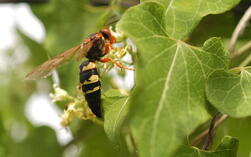
Females are responsible for locating cicadas and paralyzing them with their stinger. She then carries the cicada back to her burrow. Each burrow can house up to 20 cicadas.
Life Cycle: Adult females lay a single egg on each cicada they drag into the ground. Eggs hatch in two to three days into legless, white grubs which feed on the cicada. The larvae then create a protective case in which to overwinter. Adult wasps die in early fall. In spring the larvae pupate in the pupal cases and emerge as adults in June/July. There is one generation per year of cicada killers.
Damage: Cicada killers typically cause very little damage to the landscape. A heavy infestation may become a nuisance as they protect their nests. The burrows may be considered unsightly, especially in a lawn area.
Control: Cicada killers prefer well-drained, light soils in full sun. They may burrow along sidewalks or flowerbeds but do not like areas covered with mulch. Maintaining a thick, healthy lawn is the best control for preventing burrows. Pesticides are not usually necessary since adults are only present for about two months beginning mid to late summer, but Permethrin may be used for control. Treat the burrows at dusk when females have returned. Males are often found perched nearby. Products with permethrin include:
(Dusts) Eight Garden Dust – Bonide, Multipurpose Garden and Pet Dust - Green Thumb Garden, Pet & Livestock Dust - Hi-Yield
(Liquids) 38 Plus Turf, Termite & Ornamental Insect Spray - Hi-Yield, Eight Vegetable, Fruit & Flower Conc. – Bonide, Eight Yard & Garden RTS – Bonide, Garden and Farm Insect Control- Hi-Yield (Cynthia Domenghini)
 RSS Feed
RSS Feed
